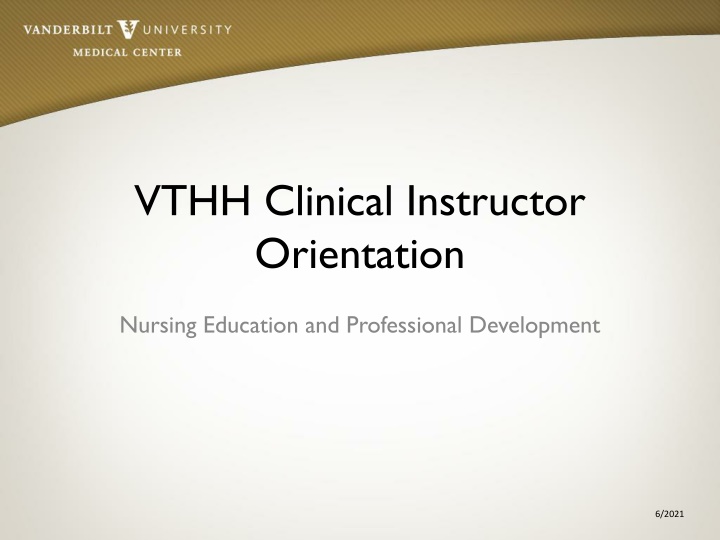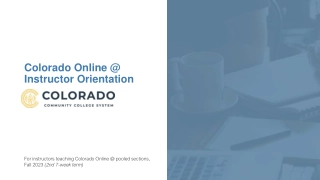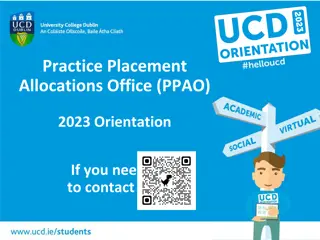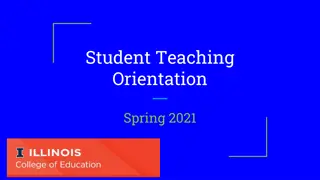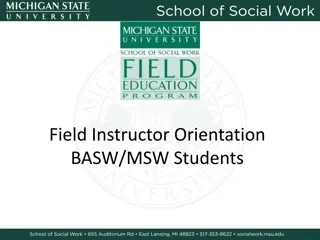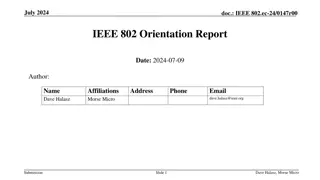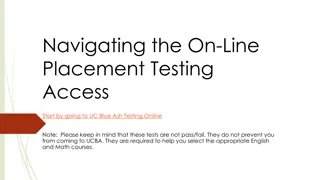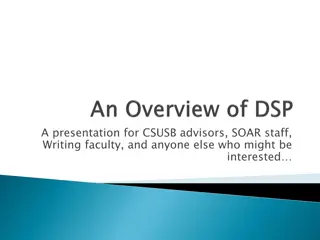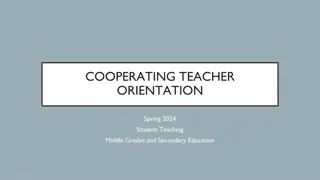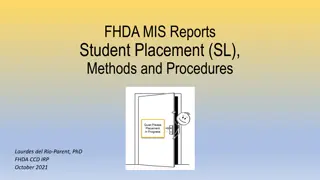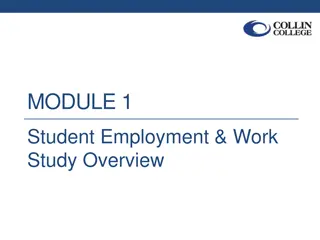Clinical Instructor Orientation & Student Placement Guidelines
This content covers objectives, instructor responsibilities, group placements, observational experiences, and emergency codes in a nursing education setting. It emphasizes guidelines for student placements, observational experiences, and emergency protocols.
Download Presentation

Please find below an Image/Link to download the presentation.
The content on the website is provided AS IS for your information and personal use only. It may not be sold, licensed, or shared on other websites without obtaining consent from the author.If you encounter any issues during the download, it is possible that the publisher has removed the file from their server.
You are allowed to download the files provided on this website for personal or commercial use, subject to the condition that they are used lawfully. All files are the property of their respective owners.
The content on the website is provided AS IS for your information and personal use only. It may not be sold, licensed, or shared on other websites without obtaining consent from the author.
E N D
Presentation Transcript
VTHH Clinical Instructor Orientation Nursing Education and Professional Development 6/2021
Objectives Identify Orientation Requirements Discuss Group Placement Guidelines Identify Instructor Responsibilities Discuss Student Expectations Discuss Performance/Incidences Process
About VTHH Tower MT/ST-2nd floor CCU-3rd floor Main Building OB-2nd Floor PCU-3rd floor OR/PACU/SDS-1st floor ER-1st floor
Overhead Alerts Red Alert = Fire Yellow Alert = Prepare to activate Emergency Plan Orange Alert = Activate Emergency Plan Code Pink = Missing infant (younger than 12 months old) Code Purple = Missing child (ages 1to 12 years) Code Walker Adolescent = Missing adolescent (ages 13 to17) Code Walker Adult = Missing adult (17+) Code Silver = active shooter Code Green = Psychiatric Emergency at VPH Code Black = Bomb Threat STAT = Life threatening emergency
Group Placements Placement reserved in SharePoint Submission of Student Data Grid (by school coordinator) Group of 6 students max (up to 18/semester) Assigned to one clinical area Students should not rotate off unit Few exceptions allowed
Observational Experiences Students in clinical groups should not observe/shadow in areas outside of their assigned clinical unit Students in clinical groups may, however, follow an assigned patient along the continuum of care in an observational status when approved by the clinical instructor and the procedural contact person Students should not accompany patients to MRI
Observational Experiences All requests for Observation / Shadow Experiences are handled through VOE Vanderbilt Observation Experiences (voe@vumc.org) Nursing students currently in clinical rotation are not eligible
Thinking Point Student is assigned to a patient who is scheduled for an interventional radiology procedure and asks you if they can go with their patient. Which response is the most appropriate? A: No, absolutely not. You are never allowed to leave this unit during your rotation B: Yes, feel free to go with them. Have a wonderful experience! C: Let s see if we can make that work, I ll discuss with the shift leader on our unit and down at interventional radiology.
Instructor Orientation Requirements Experience in specialty area of clinical rotation Clinical Instructors New to VUMC: 2 12 hour shadowing shifts with a staff nurse Completion of Orientation Checklist Returning Clinical Instructors (to same unit): Shadowing shift - as needed (none required) Returning Clinical Instructors (to new unit): 1to 2 12 hour shadowing shifts with a staff nurse (if you have not taught on the unit > 12 months) Completion of Orientation Checklist
Instructor Orientation Requirements VUMC Employees assigned unit other than home unit: 1 12 hour shadowing shift with a staff nurse Completion of Orientation Checklist VUMC Employees working on home unit: Completion of Orientation Checklist
Instructor Orientation Requirements Vanderbilt issued ID badge with school name Indicating you are a visiting instructor Applies to VUMC employees (should NOT wear their VUMC employee badge during rotations)
Clinical Instructor Responsibilities Clinical instructor MUST: Be present on unit Determine student assignments in collaboration with the charge nurse, CSL, and/or delegate Review and co-sign all student documentation Accompany the student in performance of assessments, skills, procedures and medication administration to assess and verify his/her performance
Clinical Instructor Responsibilities Instructors and students will be on the floor ready to get report at the designated time Assignments will be documented on the Assignment form by the clinical instructor and given to the charge nurse/CSL Objectives and goals of the clinical experience should be communicated to the unit
Nursing Student Assignment Sheet
Thinking Point You are prepping your students assignments the night before clinical. What is the most appropriate process for determining how best to place them? A: Call the night shift leader and ask which nurses to assign your students to B: Go in prior to students arrival and communicate with shift leader to determine appropriate patients for students C: Write down student assignments on assignment sheet and leave at the medical receptionist desk
Educational Guidance Instructor / Student will receive a handover communication from the assigned nurse Student performs care under the supervision of the Clinical Instructor or Licensed Care Provider Before leaving the clinical area, the student will provide a handover communication to the assigned nurse Policy # CL 30-08.04 Clinical Handover Communication
Friendly Reminders Please do not hold pre and/or post conference in public areas Please be cognizant of congregating and/or clustering on the units especially at the nurses station Please do not contact the unit or unit leadership for questions about Student Placement. Use student.placement@vumc.org for all Student Placement inquiries
Student Expectations Dress Code in the Clinical Setting: Students will arrive in the clinical area with a school lab coat and/or school badge on their scrubs Injuries incurred that require support (i.e casts, boots, crutches etc.) are outside of the dress code policy, and clinical rotations must be paused in this instance Hair should be worn in such a manner it does not come into contact with patients or visitors Artificial nails, perfume/cologne or open-toed shoes are not permitted No revealing attire, bandanas or hats are permitted Visible body piercings are restricted to the ears Visible tattoos must be concealed Policy # CL 20-06.05 Dress Code and Personal Appearance
Student Expectations Student ID Badges Vanderbilt ID badges must be visible above the waist and worn at all times Students are not to independently transport any patient unless approved by the instructor and/or charge nurse Students are not to independently transport monitored and/or unstable patients at any time Policy # CL 30-03.05 Transport of Patients
ID Badges Photos Once you have created a valid VUMC ID, and have waited 2 hours for it to process, you may follow the steps below to upload a selfie for your badge photo. Go To: https://hr.vumc.org/cardservices/photos -Enter Vanderbilt VUMC ID (all lower case) -Enter Password -Select Submit ID Photo from the menu Make sure the photo follows the proceeding specifications: For Instructors/Students who do not have a school issued badge with their photo included on it
ID Badges The Photo Must: Be in color Clearly identify YOU from head to shoulders only Have no noticeable reflections or glares, especially from glasses Have a solid white or off-white background Have normal contrast and lighting You Must: Be the only person in your photo Face forward, looking directly into the camera (no side profiles) Have no red eye Have nothing touching your face such as hands, props or other distractions Not make any gestures or inappropriate facial expressions Not wear a hat or sunglasses Not wear jewelry or garments that obstruct the view of your face Look happy! If the photo DOES NOT meet these requirements- it will not be accepted
Thinking Point One of your students comes to clinical with only their school student ID badge and a VUMC t-shirt. They state I forgot my badge at home, but the staff nurse told me I could wear this shirt. The best response is: A: You are not allowed to be in clinical out of appropriate dress code and without a VUMC ID badge B: Go home for the day- you haven t met the appropriate requirements C: As long as you have your school ID badge you will be good D: Dress code specifies that you must be in your school uniform with your school ID badge
Parking All Students and Instructors are Required to park between the Yellow lines on the Back Row of the Parking lot. Additional Parking if needed is located to the side the hospital where the loading dock is located.
Student Expectations Social Media Policy OP 10.10-30 Communications through personal media during clinical time is prohibited (Facebook, Twitter, personal phone calls, texting etc.) Personal phone calls should not be taken in the clinical area Students who need to provide their families with emergency numbers should provide them with the unit number Pictures should not be taken in any clinical area
Thinking Point You have a student that claims they are using their cell phone to look up medications while in a patient room. Which of the following is NOT true? A: Per VUMC policy, you are allowed to utilize your phone to look up information B: Per VUMC policy, you are not allowed to communicate via social media during clinical time or in clinical care areas C: It is ideal to avoid using a personal cell phone in patient care areas due to perception from patients of lack of quality care D: No cell phones are allowed in patient care areas
Performance Feedback Rounding on units Completed by Student Placement Team Done throughout the semester Instructors / Students / Staff Questions or Issues to: student.placement@vumc.org
Chain of Inquiry Conflict resolution is best done with immediate feedback in the moment. If, however, practice or concerns are beyond immediate resolution between 2 or more individuals, please follow the below steps for follow-up STUDENT HAS A CONCERN Student TO Clinical Instructor Clinical Instructor TO School Coordinator School Coordinator TO student.placement@vumc.org Program Manager will elevate to entity-specific lead Lead will communicate with unit leadership UNIT STAFF HAS A CONCERN Unit Staff TO Unit Leadership Unit leadership TO Student Placement Lead Student Placement Lead TO School Coordinator School Coordinator TO Clinical Instructor Clinical Instructor TO Student
Chain of Inquiry Please do not contact unit educators or managers regarding questions Students should never speak with anyone except their school coordinator/instructor about their concerns and then those can be communicated to student placement via the school coordinator Student placement will communicate with unit educators/managers
Occurrences / Incidences Faculty / Instructor Performance Issue Unit educator/manager will report to NEPD via phone/email; Lead will report to school coordinator and request school coordinator respond with an action plan Depending on the severity of the performance issue, student placement lead may request removal from clinical site Student Performance Issue Faculty / instructor will address per school policy
Thinking Point You have a student that is struggling with time management and is not ready to administer medications by the scheduled time. They are now 2 hours overdue and the student has not communicated this to you. A staff nurse comes to you complaining the students are slowing me down, I can t complete my morning work appropriately. What would you anticipate as the appropriate conflict resolution? A: The students have no idea what they are doing. They should just give the medications and we can document them later B: I am sorry that this was missed- would it be more helpful for you to give the morning medications and let me talk with the student to determine if we can manage the noon meds? C: Give me a break! You are responsible for your patients- you should have known better than to wait until 2 hours past when meds are due. D: We do not give medications as part of this clinical rotation. The students should have told you that at the beginning of the shift.
Thinking Point After the previous conversation you overhear the nurse negatively discussing yourself and your clinical group at the nurse s station. The following week, this same nurse is working with students and refusing to let them provide any care and telling them you are not safe to practice- I don t think any of you will make it as nurses Given that you have appropriately communicated the shift s plans and goals for the day with the staff, what are your next steps? (check all that apply) A: Pull the nurse aside at a down moment and discuss the situation with him/her B: Document the incident C: Send documentation of the incident to your school coordinator D: Report the nurse to the unit manager E: Remove the students from the clinical setting for the remainder of the day F: Use this situation as a learning example for your students of workplace conflict
Needle sticks & Splashes Wash needle sticks with soap/water Flush splashes to nose, mouth, skin with water Irrigate eyes with clean water, saline, or sterile irrigates (Eye wash stations available in many areas) Get the name, Medical Record #, and location of the exposure source Notify preceptor and Charge Nurse/CSL Fill out Tennessee First Report of Work Injury Go to Emergency Department (if after hours) for an evaluation Contact your faculty for any school specific procedures
Personal Injury Complete TN 1st Report of Work Injury Report to Adult ED for emergency care Report to personal PCP or School s student health department
Questions? Contact Student Placement @ student.placement@vumc.org
